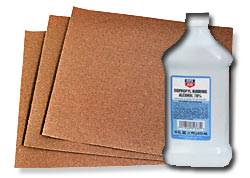There are some dangerous ways to get a little entertainment- sky diving, mountain climbing, and even playing the guitar safely at home. Newcomers to the guitar will find out the hard way that fingers and hands will certainly become callused, and may experience a little pain and tenderness to the touch as a result.
Professional guitar players feel no pain. Their fingers will have thick calluses, developed over years of playing. However, there are a few tricks of the trade that can help speed up the process.

Figure 1 – You won’t have the best looking hand in the world- but it can play a mean guitar!
What are Calluses?
Calluses are thickened or hard parts of a certain area of skin. This is a result of rubbing, or pressure, and no doubt they have been experienced before on feet or hands. Most people don’t already have hardened fingertips, though, specifically the index finger on the left hand (the hand you fret with). As a newcomer begins to play more and more guitar, the fingertips may well feel tender. Blisters may even form. This can even affect your guitar playing, causing pain when you press your fingers against the strings. It is best to wait the tenderness out and wait for skin to heal. As it does so it hardens. Taking a few days away from the guitar will allow your body to respond to the stress it is being put in. As a guitarist, calluses are your friend. They let you play much longer and much harder!
Not everyone likes the idea of hardened finger tips. For instance, feeling in the fingertip will be diminished. The extra hardened layer of skin will make soft materials invisible to touch. In truth this only effects a small part of the finger, so should not be a serious issue. They may look somewhat unsightly. Some people don’t relish the look of frayed or blistered fingertips, or those with flaps of skin hanging off. For these people, there are alternatives that will most likely make them look more foolish than desired. From taping fingertips, to putting on band aids – to even using enough lotion to make your parents wondering what you’re doing with all of it. However, most people settle with the idea, and of course still have the plucking hand to experience soft ouch (of course, if a plectrum is used). Finger style bass players usually have calluses on both hands.
How to speed up callus growth
Looking to bypass the grooves, puffiness, and red flushing of the fingertips? There are a few tricks of the trade to get calluses to form faster. Soaking fingertips in rubbing alcohol for a minute or two each day will dry out the skin on fingertips – and will make calluses form much faster. Interestingly, rock climbers have the same need for calluses – and have a device to build them much faster. This device is small, ridged, and is meant to be scraped continually against fingertips. If desired, they can be bought at most hobby shops, but a makeshift device can be used as well; sandpaper, or a pumice stone would be usually be sufficient.

Figure 2 – Whoever said playing the guitar was easy needs to rethink that statement!
Ultimately, growing calluses takes a lot of guitar practice and a lot of patience. But this is all good, there is no point having strong fingertips if you can’t actually play! Some harder to get calluses, such as the pinky finger, can take months or even years to develop, but then if you only occasionally use that finger it probably won’t be an issue. The process can’t be bypassed completely, however, and red, puffy, fingertips should be expected for newcomers. If all else fails, get a little help from everyday objects such as rubbing alcohol or sandpaper (be careful- you don’ want to cause damage! Gently rubbing sandpaper is good enough). Be sure to rub the top right-hand edge of each finger on the left hand (assuming you are right handed) – the part that presses against the string. Calluses don’t form on the soft pads on the front of your fingers.
Emergency artificial calluses
Extreme situations demand extreme measures. You’ve got a super-important gig on Saturday, but your fingers are shredded from rehearsals on Thursday and Friday. You’ve got blisters and are in pain. Some guitarists will resort to applying super glue on their finger tips, to create a thin layer over most painful areas. This is no substitute for developing your own calluses, but it may just get you through the show!
Once you have been playing a few years, you won’t even think about your guitar playing calluses. You will just enjoy playing and feel no pain. The first few months of being a guitarist can be a little uncomfortable, but persevere, and in no time and determination, you too can achieve the calluses of a professional.

Damn I need those calluses!!!
Can you play guitar long enough to where you lose the feeling in your fingertips or no?
how long should your soak your fingers in alcohol and for how many days should you do it?
My problem is that I have been playing so long, my calluses on my finger tips hurt. I am trying to figure how to alleviate that issue.
Any suggestions welcome
I’ve been playing for 16 years. The last few months, I’ve been playing up to 6 hours in a day. It’s incredibly painful and I have well-formed calluses. How do I relieve the pain from overplaying? I don’t want to stop practicing.